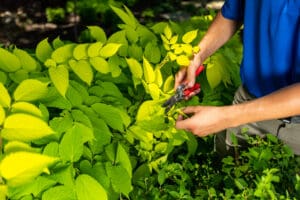Winter damage or burn on broadleaf evergreens shows up when temperatures start to increase in early spring. The damage occurs when the evergreen plant loses water through its leaves faster than it can replace it from the soil. During the winter, this occurs when the weather is cold and windy, the ground is frozen, and the plant is unable to take up water. When the weather is warmer, the plant takes up water through the roots so that the leaves are better able to sustain water loss. If the soil is dry and the plant can’t take up water during warmer periods, then the damage is more severe.
How do you prevent winter damage?
Water broadleaved evergreens in the fall during dry spells, especially those that are newly-planted. You may need to water once or twice during the winter when the ground is thawed, more regularly if the plants are in containers. Particularly sensitive plants such as camellias should be planted in sheltered locations, out of the wind.
What to do now?
Give the plants a good soaking. Let the damaged leaves drop, they will be replaced by fresh leaves soon. For evergreen perennials such as hellebores or epimedium, remove the old damaged leaves and stems, taking care not to cut off the newly emerging leaves and/or flowers.
If the entire shoot looks dead, scratch the stem with your fingernail. If it is green beneath the bark, it is still alive and may send out new leaves. If it looks dry beneath the bark like a toothpick, then the shoot is probably dead. Regardless, wait a few weeks to see where new growth emerges before you prune out dead shoots, or pull out the plant. Unless you are an experienced gardener, it’s best to wait until mid-or late April before pronouncing the patient dead.



